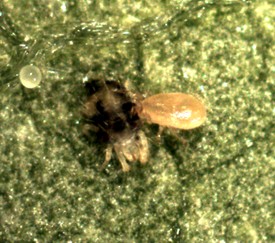Growing strawberries under high tunnels can extend the harvest season, provide protection against rain, frost, and disease, and improve overall yield and fruit marketability. Pest pressure, however, can be higher on protected culture strawberry compared to the open field. This is especially true for small, soft-bodied pests such as spider mites, aphids, and thrips. Even during the winter, temperatures can be warm enough under the high tunnels to allow these pest populations to slowly build, leading to large pest outbreaks in the spring. Management recommendations are therefore needed that are effective during the winter and early spring to prevent economic injury.
Our team is determining how row cover management impacts pest presence, and which biological control agents are effective against pests during the winter. At the Southwest Purdue Ag Center and Meigs research farms, ‘Chandler’ strawberries were transplanted under high tunnels in the Fall 2022. Row covers were either actively managed (i.e., removed daily when temperatures were above 50°F) or passively managed (i.e., covers were left in place during the winter until spring). Control rows were also included that did not receive any row covering. Pests were monitored every two weeks until early May.
Aphids and twospotted spider mites (TSSM) were the dominant pests identified on strawberries during the 2022-23 winter / spring season. At Meigs, three predator species were tested against aphids (Chrysoperla carnea, Orius insidiosus and Adalia bipunctata) and the predatory mite species Neoseiulus fallacis was released against TSSM at SWPAC. Aphid predators were released in mid-February in 2023, and N. fallacis in Nov. 2022.
We found that row covering profoundly affected the presence of TSSM and aphids (Fig. 1). For both pests, higher densities were observed under row covers compared to open beds, regardless of how the row covers were managed. Both pest populations crashed when row covers were removed in February, likely due to cold temperature and natural enemy exposure. Both TSSM and aphids increased in density during March. Markedly high numbers of TSSM were observed in the “passive” covering treatment in March (after covers were removed), indicating a high number of eggs or overwintering individuals in this treatment that reinitiated activity and reproduction in March.

Figure 1. Change in TSSM and aphid populations from Oct 2022 to April 2023 as affected by row covering treatment at SWPAC. The “release” arrow indicates when predatory mites were released against TSSM. A second arrow indicates when row coverings were permanently removed due to warming Spring temperatures.
TSSM populations decreased rapidly after predatory mites were first released (Fig. 2). Predatory mites did not seem to have a consistent preference for any covering type and were less impacted by the removal of the row covers compared to TSSM. Fewest predatory mite numbers were recovered during the cold winter months, and increasing numbers were observed starting in February. However, TSSM populations were observed to increase in the Spring, warranting additional biocontrol agent releases or management practices. These results indicate that N. fallacis, and potentially other naturally occurring predatory mites, overwinter well under high tunnels but additional management may be necessary in the Spring to prevent TSSM outbreaks.
When comparing efficacy of aphid predators at Meigs, our first release indicated that Adalia bipunctata was most effective in reducing aphid densities. This research is ongoing, however, so definitive results are pending. Recovery of all released biocontrol agents at the Meigs site was low. Syrphid fly larvae, however, are naturally occurring and voracious aphid predators and were recovered at higher densities compared to the augmented biocontrol agents. The adults of this fly are also important strawberry pollinators, so they are a great insect to have around. Syrphids were first observed in early April, as well as natural parasitoids as indicated by the presence of aphid mummies (Fig. 3). We therefore suggest avoiding the application of broad-spectrum insecticides and unnecessary pesticides to strawberries in early April when natural biocontrol agents and pollinators are present. See Fig. 3 for photos of common aphid natural enemies and syrphid fly adults.

Figure 3. Common aphid predators that can be purchased (indicated by an asterisk next to the species name) or found naturally.
Please see this video and podcast for more information on the high-tunnel strawberry production system and the biological control of insect pests.
